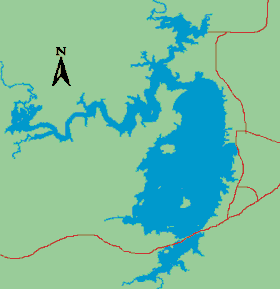Fishing
- Licenses & Regulations
- ShareLunkers
- Fish Identification
- Fish Consumption
- Texas Freshwater Fisheries Center
Water Resources
- Texas Reservoir Levels
- US Army Corps of Engineers
- Texas Water Issues
- Golden Alga
- Aquatic Vegetation
PO Box 1446
Pottsboro, Texas 75076
(903) 786-2389
Dan Bennett, Biologist
Local Information
- Bridgeport Chamber of Commerce
PO Box 1104
Bridgeport, Texas 76246
(940) 683-2076
Nearby State Parks
Lake Bridgeport
Quick Links: Fishing Regulations | Angling Opportunities | Cover & Structure | Tips & Tactics
BOATER ADVISORY: Zebra mussels have invaded this reservoir! CLEAN, DRAIN AND DRY your boat, trailer, livewells/bait buckets, and other gear before traveling to another water body. Draining water is required by law and possession and transport of zebra mussels is illegal.
Lake Characteristics
Location: On the West Fork Trinity River
in Jack and Wise counties, off US Highway 380
Surface area: 11,954 acres
Maximum depth: 85 feet
Impounded: 1932, renovated in 1972
with a new spillway
Water Conditions
Current Lake Level
Conservation Pool Elevation: 836 ft. msl
Fluctuation: Average 12 feet annually
Normal Clarity: Moderately clear
Reservoir Controlling Authority
Tarrant Regional Water District
1710 FM 1658
Bridgeport, Texas 76426
(817) 335-2491 central office
(940) 683-2349 local
Aquatic Vegetation
Sparse colonies of American pondweed and American lotus.
Predominant Fish Species
- Largemouth bass
- Smallmouth bass
- Spotted bass
- White bass
- Hybrid striped (palmetto) bass
- Channel catfish
- Crappie
- Sunfish
Lake Records
Current
Fishing Report
Stocking History
Latest Survey Report
Lake Maps
Commercial maps can be purchased at local sporting goods stores.
Fishing Regulations
All species are currently managed under statewide regulations.
Angling Opportunities
| Species | Poor | Fair | Good | Excellent |
|---|---|---|---|---|
| Largemouth & Smallmouth Bass | ||||
| Spotted Bass | ||||
| Catfish | ||||
| Crappie | ||||
| White & Hybrid Striped Bass | ||||
| Sunfish |
Fishing Cover/Structure
Most of Lake Bridgeport's 170-mile shoreline is good bass habitat, with 7 miles of rip-rap, 90 miles of boulders, and many coves and points. Near the Lakeview Lodge on the Sid Richardson Scout Ranch, near Windy Point, Captain Kidd Point, and Steele Island, there are submerged gravel piles that were deposited when the West Fork Trinity River flowed free and uncontrolled. These piles provide excellent habitat for white bass and black basses.
Tips & Tactics
Crappie are caught most often when the fish school around structure in deep water in the winter and in the spring when they come into shallow water to spawn. Many main-lake points, ledges, and channels provide excellent wintertime habitat. In spring, two of the best spots for crappie are Bean Creek and Big Creek. Fish year round with minnows or jigs. Channel catfish are best in the spring when tributaries are running, and again in summer when the fish concentrate atop submerged flats and can be drift-fished with shrimp or cut bait. Similar baits pay off during inflow during the spring and summer.
White bass fishing is best during the spring spawning run. All main-lake points and any inflowing tributaries are good producers. In summer you are likely to see white bass anywhere: in front of the dam, near Rattlesnake Island in open water, and around submerged gravel piles. Best baits here are surface lures, plastic shad, small spoons, jigs, and live minnows or shad. Hybrid striped bass are attracted to similar locations and baits. In winter, hybrids can usually be found feeding on shad and drawing the attention of hundreds of sea gulls.
Black basses in this lake include largemouth, spotted, and smallmouth bass. They can be caught almost year round, but spring and fall are tops for action. For trophies, try fishing in February and March. Effective baits in spring include a Carolina Rig worm or 6-inch lizard, a Texas rigged worm (7-inch variety), and crankbaits. On into summer, jig and pig, spoons, Texas rigged worms, and crankbaits work well. In fall, try crawfish-mimicking baits, spinners, and jigs in turbid and shallow water. Roll a spinner bait, bump a crankbait, or dabble a Texas rigged worm over one of the submerged gravel humps and you better be holding to something solid.
